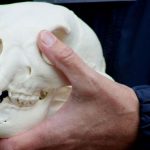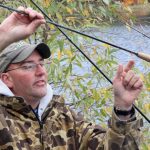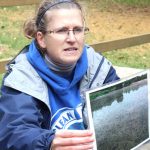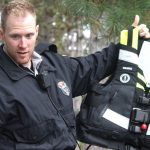State park hosts annual field day
By Greg Seubert
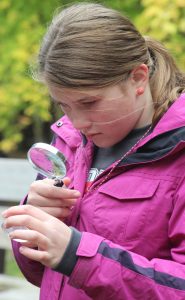
All Paul Skawinski needed was a lake, a bed of plants and a net.
After spending a few minutes dipping the net into Hartman Creek State Park’s Hartman and Mid lakes, he had a bucket full of fish, bugs, frogs and other critters.
Skawinski, citizen lake monitoring network educator with University of Wisconsin Extension’s Lakes Program, spent part of Oct. 7 at the park for the annual Waupaca County Conservation Field Day. The Stevens Point-based Golden Sands Resource Conservation & Development Council holds the event at the park each year. More than 300 fifth-graders throughout Waupaca County and their teachers attended.
Skawinski was one of nearly 20 presenters. He focused on aquatic plants, while other stations provided information on forestry; fishing; composting; agriculture; conservation law enforcement; boating safety; soil conservation; wetlands; aquatic invasive species; and gardening.
“I’m telling them about aquatic plants,” Skawinski said. “These tubs here are illustrating the diversity of critters that occur in beds of aquatic plants. Without those aquatic plants, we start to lose these animals. They all get to look at and touch some frogs, crayfish, dragonflies and fish.
“This is all stuff I was able to collect in about a half-hour before the station started here and it was all with a net,” he said. “We have bluegill, rock bass, largemouth bass, dragonflies, crayfish, tadpoles, a green frog, caddis flies, a freshwater sponge and a giant water bug, all kinds of neat stuff.”
Skawinski was able to come up with five species of fish from one plant bed.
“They go into plant beds to find shelter and eat little tiny plankton and other critters that are on the plants themselves,” he said. “That’s really the most important piece of the food web in a lake, this near-shore area where there are lots of aquatic plants. All these creatures go there to grow up: fish, bugs, turtles, frogs, everything. If there are not enough plants for these things, the bigger fish can get right in there and grab them all. They need small beds of plants so they can find a safe place to hide.”
The field day allows the students to learn something up close instead of in a book or on a website, according to Skawinski.
“I’m talking about a lot of native animals and one non-native thing in here, the rusty crayfish, how they were brought here as bait and released illegally,” he said. “Having them see this diversity of life, it drives home the point with the kids that we bring in these invasives and all these neat things that are natives start to disappear. I think it’s an easy way for them to understand that idea.”
Skawinski said he hopes the students can relate to what they learn from the presenters.
“Ideally, I’d like to see them be able to name a few things so when they go up to the cabin or they’re out fishing with a friend, they can say, ‘Hey, that’s called a green frog, this is a dragonfly and this is a crayfish,” he said. “Just knowing the names of a few things starts to develop a sense of appreciation.”
Students visiting Skawinski’s station also identified a handful of aquatic plants.
“When you know the name of something, you appreciate it more,” he said. “Instead of saying, ‘That’s seaweed out there,’ they can say, ‘That’s a bulrush. I remember this guy in Waupaca told me about bulrushes and how damselflies lay their eggs right into bulrush stems.’ They remember those little things and they’ll pass them along to other people.”

